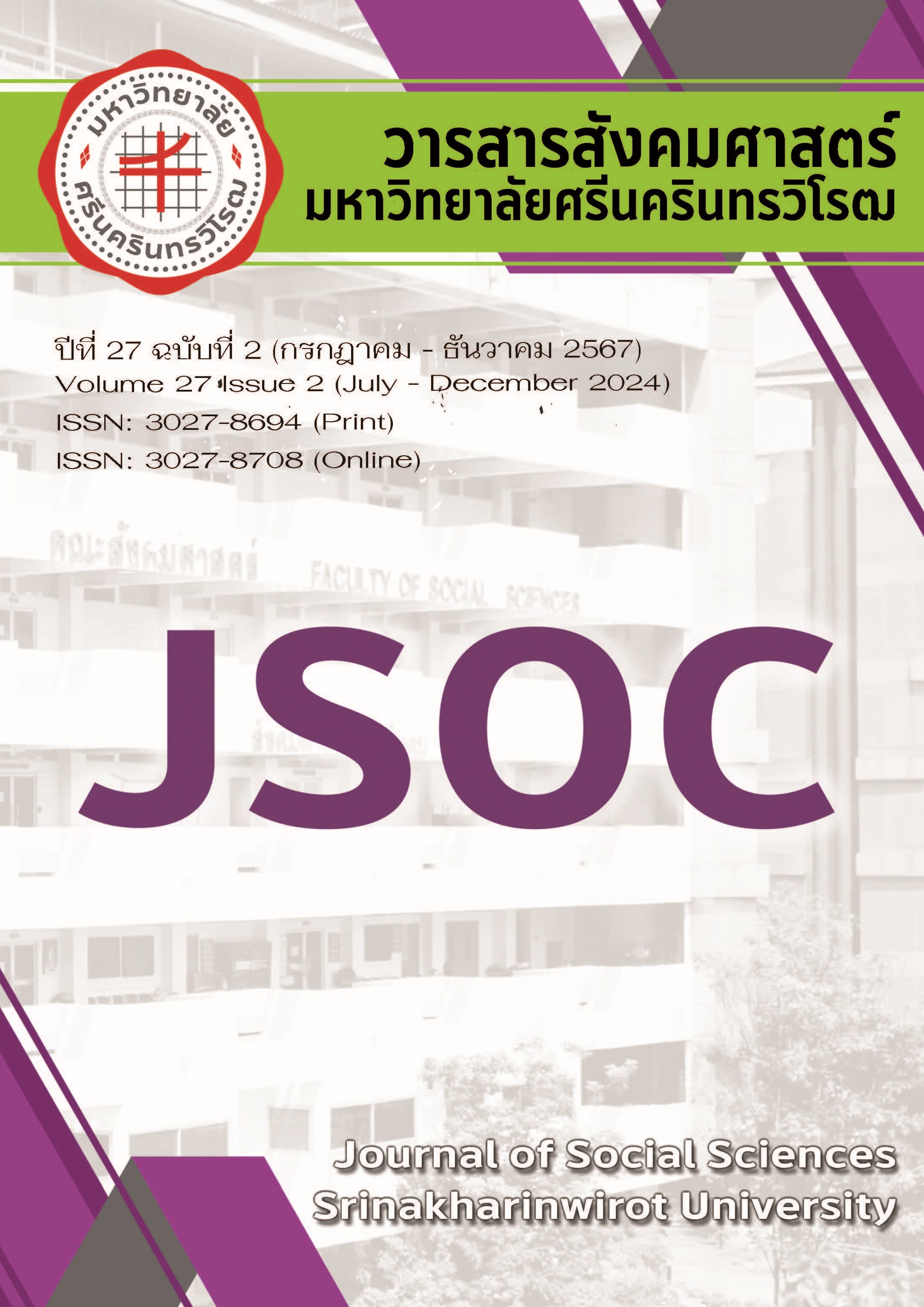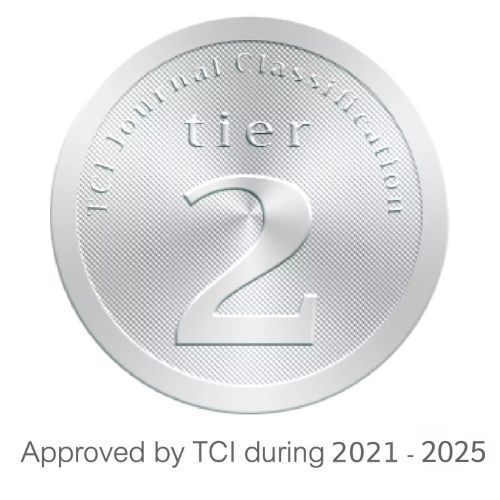ความเข้มแข็งของชุมชนและการพัฒนาเครือข่ายภายใต้การพัฒนาที่ยั่งยืน: ศึกษากรณีชุมชนริมคลองแสนแสบ
Community Strengths and the Development of Networks under Sustainable Development: A Case Study of Communities along Saen Saeb Canal
Keywords:
ความเข้มแข็งของชุมชน, การพัฒนาเครือข่าย, การพัฒนาอย่างยั่งยืน , ชุมชนริมคลองแสนแสบAbstract
การวิจัยนี้เป็นการวิจัยเชิงคุณภาพ โดยมีวัตถุประสงค์เพื่อ 1) ศึกษาความเข้มแข็งของชุมชนริมคลองแสนแสบ เขตวัฒนา กรุงเทพฯ ภายใต้กรอบการพัฒนาอย่างยั่งยืน 2) ศึกษาความต้องการของกลุ่มและเครือข่ายในชุมชนดังกล่าว และ 3) นำเสนอข้อเสนอแนะเชิงนโยบาย โดยการเก็บรวบรวมข้อมูลจากเอกสารจากหน่วยงานและเอกสารอื่น ๆ ที่เกี่ยวข้อง รวมถึงการสัมภาษณ์ตัวแทนหรือผู้นำชุมชน จากนั้นจะวิเคราะห์ข้อมูลด้วยวิธีการวิเคราะห์เนื้อหา และนำเสนอผลการศึกษาโดยการพรรณนา ผลการวิจัยพบว่า 1) ตัวแทนชุมชนมองเห็นจุดแข็งที่สำคัญของชุมชนคือ ที่ตั้ง ซึ่งสะดวกต่อการคมนาคม สมาชิกมีความสามัคคี พร้อมช่วยเหลือกิจกรรมส่วนรวม และเล็งเห็นความสำคัญของการประสานงานกับหน่วยงานภายนอก เพื่อพัฒนาชุมชน 2) ตัวแทนชุมชนตระหนักดีว่าการสร้างชุมชนที่ยั่งยืนเป็นเรื่องยาก แต่หากมีองค์กรภาครัฐเข้ามาช่วยเหลือ ก็อาจจะสำเร็จได้ และ 3) ข้อเสนอแนะเชิงนโยบาย ประการแรก การสร้างความตระหนักรู้เกี่ยวกับปัญหาของชุมชนให้กับคนในชุมชนเพื่อกระตุ้นให้เกิดความเข้าใจ และความต้องการที่จะเข้ามามีส่วนร่วมแก้ไขปัญหาเป็นสิ่งสำคัญ ประการที่สอง ภาครัฐ เอกชน และภาคประชาชน ต้องตระหนักถึงความสำคัญของการร่วมมือกันในลักษณะเครือข่าย เพื่อการบรรลุเป้าหมายหรือการแก้ไขปัญหาในสังคมที่มีความสลับซับซ้อน ประการสุดท้าย มหาวิทยาลัยศรีนครินทรวิโรฒควรให้การสนับสนุนชุมชนทั้งในมิติของการให้ความรู้ ความเข้าใจเกี่ยวกับปัญหาและวิธีการแก้ไขปัญหา และกำหนดเป็นพันธกิจของมหาวิทยาลัยในฐานะศูนย์กลางในการสร้างและพัฒนาเครือข่ายให้กับชุมชนจนกว่าชุมชนจะพัฒนาไปสู่ความเข้มแข็งและการพึ่งตนเองได้สำเร็จ (This research is a qualitative study with the following objectives: 1) to investigate the strength of the San Saeb Canal communities in the Wattana district of Bangkok, within the framework of sustainable development 2) to study the needs of the communities and networks and 3) to propose policy recommendations by collecting data from relevant organizations, other documents, and conducting interviews with community representatives and leaders. Subsequently, the data will be analyzed using content analysis, and the study's findings will be presented through a synthesis. The research findings reveal that 1) community representatives identify key strengths of the community as its location, which facilitates transportation; unity and active participation in collective activities. Additionally, they recognize the importance of collaborating with external groups in the development and strengthening of the community. 2) Community representatives are aware that building a sustainable community is challenging but feasible with government assistance. 3) Regarding policy recommendations, firstly, raising awareness about community issues among community members is crucial to stimulate recognition, understanding, and the desire to collectively address problems. Secondly, the government, private sector, and civil society must acknowledge the importance of collaboration in a networked fashion to achieve goals or address complex societal issues. Lastly, Srinakharinwirot University should play a pivotal role in supporting communities by providing knowledge and understanding of issues and problem-solving approaches. The University should define a clear mission and role as a central support hub, fostering the creation and development of networks within communities until they can successfully build resilience on their own.)References
พนิต ภู่จินดา. (2556). การผังเมืองกับการพัฒนาเมือง. กรุงเทพฯ: สถาบันพระปกเกล้า.
นราธิป ทับทัน อารี เลาะเหม็ง และ ศศิธร คล้ายชม. (2563). ย่านและชุมชนดั้งเดิมริมคลองแสนแสบในเขตกรุงเทพมหานคร. วารสารการพัฒนาชุมชนและคุณภาพชีวิต. 8(3): 615-627.
วิจิตรบุษบา มารมย์. (2560). การประเมินองค์ความรู้ด้านเมืองยั่งยืนในประเทศไทย. นครปฐม: ศูนย์วิจัยและฝึกอบรมนิเวศวิทยาอุตสาหกรรม คณะสิ่งแวดล้อมและทรัพยากรศาสตร์ มหาวิทยาลัยมหิดล.
สมเชาวน์ บำรุงชัย. (2559). รูปแบบการพัฒนาชุมชนยั่งยืนภาคตะวันออกเฉียงเหนือตอนบนของประเทศไทย. สมาคมสถาบันอุดมศึกษาเอกชนแห่งประเทศไทย ในพระราชูปถัมภ์ สมเด็จพระเทพรัตนราชสุดาฯ สยามบรมราชกุมารี. 22(1): 70-78.
สฤษดิ์ ติยะวงศ์สุวรรณ. (2556, สิงหาคม). บทบาทขององค์กรชุมชนในกระบวนการมีส่วนร่วมเพื่อการพัฒนาชุมชนของประเทศกําลังพัฒนา: กรณีศึกษาในพื้นที่กรุงเทพมหานคร. หน้าจั่ว วารสารวิชาการ คณะสถาปัตยกรรมศาสตร์ มหาวิทยาลัยศิลปากร. 27: 203-238.
สำนักงานเขตวัฒนา. (ม.ป.ป.). คลอง คูน้ำ ลำราง. สืบค้นเมื่อ 20 สิงหาคม 2566, จาก https://webportal.bangkok.go.th/vadhana/page/sub/4018/คลอง-คูน้ำ-ลำราง
สำนักงานสภาการพัฒนาการเศรษฐกิจและสังคมแห่งชาติ. (2566). เกี่ยวกับ SDGs. สืบค้นเมื่อ 20 สิงหาคม 2566, จาก https://sdgs.nesdc.go.th/เกี่ยวกับ-sdgs/
Al-Zu’bi, Maha and Radovic, Vesela. (2019). SDG11 – Sustainable Cities and Communities: towards Inclusive, Safe, and Resilient Settlements. Bingley: Emerald Publishing.
Britannica. (2021). Urbanization. Retrieved on August 22, 2023, from https://www.britannica.com/topic/urbanization
Carayannis, Elias G. and Campbell, David F. J. (2012). Mode 3 Knowledge Production in Quadruple Helix Innovation Systems: 21st-Century Democracy, Innovation, and Entrepreneurship for Development. New York: Springer.
Cai, Yuzhuo & Lattu, Annina. (2022). Triple Helix or Quadruple Helix: Which Model of Innovation to Choose for Empirical Studies? Minerva. 60: 257-280.
Etzkowitz, Henry. (2008). The Triple Helix: University–Industry–Government Innovation in Action. New York: Routledge.
Etzkowitz, Henry & Loet Leydesdorf. (1995). The Triple Helix—University-Industry-Government Relations: A Laboratory for Knowledge-Based Economic Development. EASST Review. 14: 14–19.
Kacyira, Aisa Kirabo. (2021). Addressing the Sustainable Urbanization Challenge. Retrieved on June 30, 2023, from https://www.un.org/en/chronicle/article/addressing-sustainable-urbanization-challenge
Kanuri, Chaitanya; Revi, Aromar; Espey, Jessica and Kuhle, Holger. (2016). Cities and a Territorial Approach to the SDGs. Getting started with the SDGs in cities: A guide for stakeholders. Sustainable Development Solutions Network. Retrieved on August 18, 2023, from http://www.jstor.org/stable/resrep15872.9
Legusov, Oleg; Raby, Rosalind Latiner; Mou, Leping; Gómez-Gajardo, Francisca and Zhou, Yanan. (2022). How Community Colleges and Other TVET Institutions Contribute to the United Nations Sustainable Development Goals. Journal of Further and Higher Education. 46(1): 89-106.
Mbah, Marcellus. (2019). Can Local Knowledge Make the Difference? Rethinking Universities’ Community Engagement and Prospect for Sustainable Community Development. The Journal of Environmental Education. 50(1): 11–22.
Mensah, Justice. (2019). Sustainable Development: Meaning, History, Principles, Pillars, and Implications for Human Action: Literature Review. Cogent Social Sciences. 2019(5): 1653531.
Mok, Ka Ho amd Jiang, Jin. (2020). Towards Corporatized Collaborative Governance: The Multiple Networks Model and Entrepreneurial Universities In Hong Kong. Studies in Higher Education. 45(10): 2110–2120.
Stepputat, Finn and van Voorst, Roanne. (2016). Cities on the Agenda: Urban governance and Sustainable Development. Copenhagen: Danish Institute for International Studies (DIIS).
Tang, Hui-Ting & Lee, Yuh-Ming. (2016). The Making of Sustainable Urban Development: A Synthesis Framework. Sustainability. 8(5). Retrieved on July 18, 2023, from https://www.mdpi.com/2071-1050/8/5/492
United Nations. (2021). MDG Infographics Showing the World's Progress and the Challenges that Remain. Retrieved on July 23, 2023, from https://www.un.org/millenniumgoals/multimedia.shtml
United Nations Department of Economic and Social Affairs Population Division. (2019). World Urbanization Prospects: the 2018 Revision. New York: United Nations.
United Nations Development Programme. (2017). The SDGs in action. Retrieved on July 23, 2023, from https://www.undp.org/sustainable-development-goals
United Nations General Assembly. (2021). Open Working Group of the General Assembly on Sustainable Development Goals. Retrieved on July 23, 2023, from https://www.un.org/ga/search/view_doc.asp?symbol=A/67/L.48/Rev.1&Lang=E
United Nations Human Rights Office of the Hugh Commissioner. (2021). United Nations Millennium Declaration General Assembly Resolution 55/2 of 8 September 2000. Retrieved on July 23, 2023, from https://www.ohchr.org/EN/ProfessionalInterest/Pages/Millennium.aspx
United Nations Population Division. (2021). Urbanization. Retrieved on July 23, 2023, from https://www.un.org/development/desa/pd/content/urbanization-0








